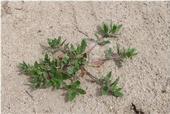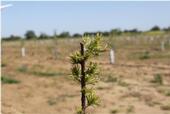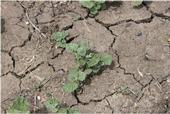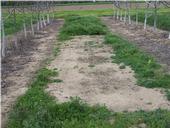- Author: Brad Hanson

Today I thought I'd share a few photos of a weed that is becoming more common in orchards in some areas of the Central Valley. I've gotten a few calls and ran across a few infestations of cutleaf eveningprimrose (Oenothera laciniata). This photo was taken in an almond orchard near Shafter, CA in early-April when it was about 6 inches across.
Weeds of California and Other Western States describes cutleaf eveningprimrose as a spreading to erect annual, biennial, or short lived perennial. At the early stages, this plant is usually sparsely hairy and leaf margins can be smooth or toothed. As the plant gets bigger and begins to spread, the leaf margins are usually deeply lobed (ie. "cutleaf"). The flowers are...
- Author: Brad Hanson

I went on a farm call last week (early May) in response to a suspected herbicide injury issue in a recently replanted almond orchard. The grower had applied a tankmix of glyphosate and Goal as a preplant burndown treatment a week or so before planting. In some areas of the field, the first leaves were badly stunted and yellowed and the grower and PCA wondered if was caused by the preplant treatment.
Although the symptoms are pretty classic for glyphosate exposure (stunted leaves, shortened internodes or "witches brooming", and chlorosis of the newest growth), this injury didn't make sense with the herbicide application in this field. There was not an obvious pattern of injury spatially across the field;...
- Author: Brad Hanson
Yesterday, I attended the Southern San Joaquin Valley Olive Day organized by UC Cooperative Extension orchard systems farm advisor, Elizabeth Fichtner (UCCE Tulare Co). She organized a nice half-day program that included presentations on weeds (from yours truly), olive disease problems, insect pests, irrigation, fertility, and economics. Industry representatives also gave updates on the state of the table olive and olive oil industries. Elizabeth is planning to post most of those presentations on the Tulare Co page (see link above) for those who weren't able to attend the meeting.
My presentation from the meeting are below and included both general orchard weed issues as...
- Author: Brad Hanson

I visited a couple of almond orchard trials this week and thought I'd share a few photos.
First, I ran across a weed that I haven't encountered before - alkali mallow (Malvella leprosa). This weed is also known as: alkali sida, creeping mallow, dollar weed, ivy-leaf sida, star mallow, white mallow, and whiteweed.
When I first saw the weed emerging in these plots, I thought it was one of the annual mallows commonly found in orchards such as common mallow, bull mallow, little mallow or high mallow (Malva neglecta, M nicaeensis, M. parviflora, and M. sylvestris, respectively). In contrast to those more familiar weeds, alkali mallow is a perennial plant that has a deep and extensive system of...
- Posted By: Brad Hanson
- Written by: Brad Hanson

I visited a couple herbicide trial sites in orchards and vineyards yesterday and saw some interesting results that follow up on my post from February 21, 2011. In that post, I discussed some 2010 work where we evaluated a number of residual herbicides applied in combination with a fairly high rate of glyphosate. You can see that poster presentation from the WSSA meeting here. As I drove past the walnut orchard trial from 2010, I had to slam on the brakes and go investigate the plot in the photo below.
After a little investigation, I determined that our application of...


